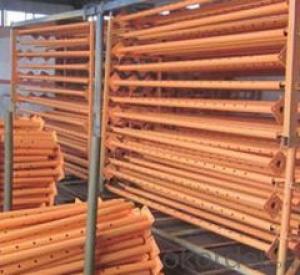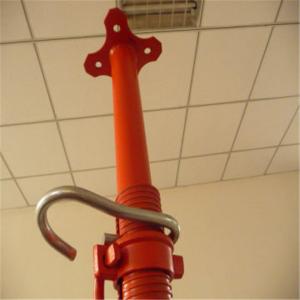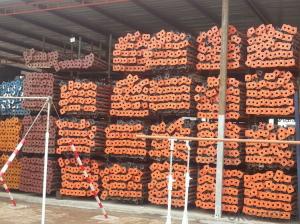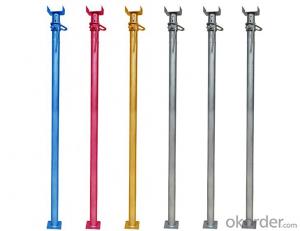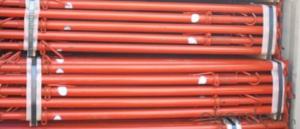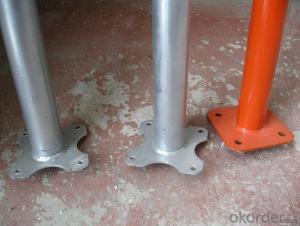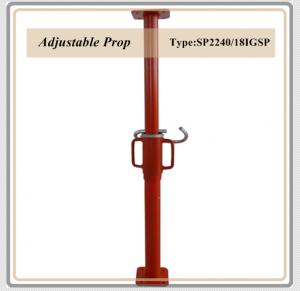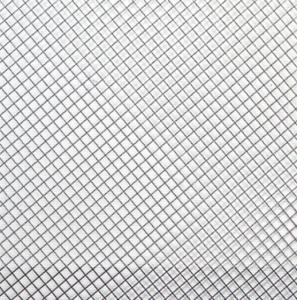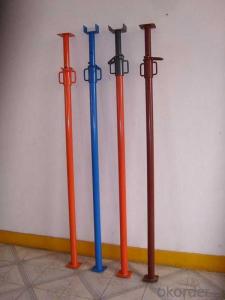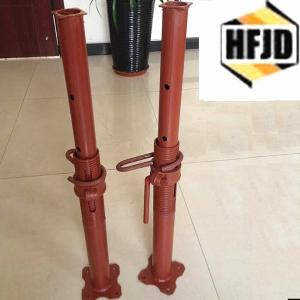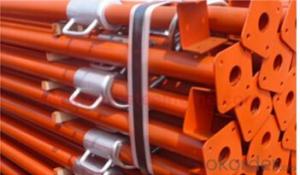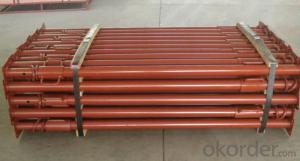heavy duty steel prop for scaffolding
- Loading Port:
- China Main Port
- Payment Terms:
- TT OR LC
- Min Order Qty:
- -
- Supply Capability:
- -
OKorder Service Pledge
OKorder Financial Service
You Might Also Like
| Brand Name: | Model Number: | ||||
| name: | surface: | package: | |||
| port:: | color: | Scaffolding Part Type: | |||
| material: | Certification: |
Packaging & Delivery
| Packaging Detail: | suitable for sea transportation |
| Delivery Detail: | Prompt |
Specifications
1.adjustable scaffolding steel prop
2.Model Size: Different size
3.Surface: Painted ,galvanized
4.Same price,better quality
adjustable scaffolding Steel prop
Scaffolding Adjustable Steel Props
Nut: Normal / Cup,
Size: Tailor mading,
Manufacturer with best price, quality & service!
2.2-3.9M Scaffolding Adjustable Steel Props
we are MANUFACTURER, can produce any size according to your demand.
this is some normal used catalog for props:
1. adjustable length: 0.8-1.4m / 1.6-3.0m / 2.0-3.6m / 2.0-3.5m / 2.2-4.0 m / 3.0-5.5 m
2. inner tube's diameter: 40 mm / 48 mm / 60 mm
3. outer tube's diameter: 48 mm / 56 mm / 76 mm
4. wall thickness: 1.6-4.0 mm
5. surface treatment: painted, e-galvanized, powder coated, hot dip galvanized
any detailed information or any questions, please contact me .
- Q:Can steel props be used in warehouse construction?
- Yes, steel props can be used in warehouse construction. Steel props, also known as adjustable steel props or scaffolding props, are commonly used in construction projects to support vertical loads. They are used to provide temporary support during the construction process, especially for formwork and scaffolding. In warehouse construction, steel props can be used to support heavy loads such as roof beams, columns, and walls. They are especially useful in situations where additional support is needed to ensure the stability of the structure. Steel props can be easily adjusted to the required height and can be used in various configurations to suit the specific needs of the warehouse construction project. Moreover, steel props offer several advantages over other support systems. They are lightweight, durable, and can withstand high loads. They are also versatile and can be easily installed and dismantled, making them a cost-effective solution for temporary support in warehouse construction. Overall, steel props are a reliable and efficient choice for supporting heavy loads in warehouse construction. However, it is important to consult with a structural engineer or construction professional to ensure that the props are used correctly and safely within the specific requirements of the project.
- Q:Are steel props adjustable in both height and width?
- No, steel props are typically only adjustable in height and not in width.
- Q:What are the potential hazards associated with using steel props?
- There are several potential hazards associated with using steel props, which are temporary supports used in construction or renovation projects. Firstly, one of the main hazards is the risk of collapse or failure of the steel props. If the props are not properly installed or are overloaded, they may buckle or collapse, leading to structural instability and potential injuries to workers or damage to the surrounding area. It is crucial to ensure that the props are correctly positioned, secured, and able to bear the intended load. Another hazard is the risk of improper handling or transportation of the steel props. These props can be heavy and cumbersome, making it challenging to lift, carry, or maneuver them safely. Workers need to be properly trained and equipped with appropriate lifting techniques and tools to prevent strain, back injuries, or accidents during handling and transportation. Furthermore, the sharp edges or pointed ends of steel props can pose a hazard if workers come into contact with them. This can result in cuts, bruises, or more severe injuries if proper precautions are not taken. Workers should be aware of the potential risks and wear appropriate personal protective equipment to minimize the chance of injury. Additionally, steel props can also present a risk of tripping or slipping if they are not properly secured or if there are obstructions in the work area. Workers should ensure that the props are stable and correctly positioned to prevent accidents or falls. Lastly, steel props can create a hazard if they come into contact with electrical wires or other live electrical sources. This can lead to electric shocks, fires, or other electrical accidents. It is essential to identify and avoid any potential electrical hazards in the vicinity of the steel props and take appropriate precautions when working near electrical installations. To mitigate these risks, it is crucial to follow proper installation procedures, conduct regular inspections to identify any signs of damage or wear, and ensure that workers are adequately trained in the safe use and handling of steel props. Adhering to safety guidelines, using appropriate personal protective equipment, and maintaining clear communication among workers can significantly reduce the potential hazards associated with using steel props.
- Q:Can steel props be used in conjunction with other support systems, such as scaffolding?
- Yes, steel props can be used in conjunction with other support systems, such as scaffolding. Steel props, also known as adjustable steel props or adjustable steel shores, are temporary support systems used in construction and renovation projects to support heavy loads or structures. They are typically used to support horizontal beams, slabs, formwork, and other vertical loads. Scaffolding, on the other hand, is a temporary structure used to provide access and support for workers and materials during construction, maintenance, or repair. It consists of platforms, support beams, and other components. In many construction projects, steel props are used in conjunction with scaffolding to provide additional support and stability. For example, if a scaffold is erected to provide access to a higher level, steel props can be used to support the weight of the scaffold and ensure its stability. Similarly, steel props can be used to support scaffold platforms or to reinforce weak areas where additional support is required. The combination of steel props and scaffolding can enhance safety and stability on construction sites, especially when dealing with heavy loads or when working on elevated platforms. However, it is important to ensure that the design and installation of both the steel props and scaffolding are in compliance with relevant safety regulations and guidelines. Proper planning, engineering calculations, and professional supervision are essential to ensure the safe and effective use of steel props in conjunction with other support systems like scaffolding.
- Q:How do you protect steel props from corrosion?
- To protect steel props from corrosion, there are several effective methods that can be employed. One of the most common approaches is to apply a protective coating, such as paint or epoxy, on the surface of the steel props. This coating acts as a barrier between the steel and the corrosive elements in the environment, preventing direct contact and subsequent corrosion. It is important to ensure that the coating is applied evenly and thoroughly, covering all exposed areas of the steel props. Regular maintenance is also crucial in protecting steel props from corrosion. This includes inspecting the props periodically for any signs of damage or wear, and promptly addressing any issues that are identified. This may involve removing any loose or flaking coating and reapplying a fresh layer, or repairing any damage to the steel surface. In addition to coatings and maintenance, another effective method to protect steel props from corrosion is through the use of sacrificial anodes. These are typically made of a metal that is more easily corroded than steel, such as zinc or magnesium. The sacrificial anodes are attached to the steel props, and they corrode over time instead of the steel. This sacrificial corrosion process helps to protect the steel props by diverting the corrosive elements away from them. It is important to note that the effectiveness of these protective measures may vary depending on the specific environmental conditions and the exposure of the steel props to corrosive elements. Therefore, it is recommended to consult with experts or professionals in corrosion prevention to determine the most suitable methods for protecting steel props in a particular setting.
- Q:Why tunnel CD method in the middle of the steel support to be bent
- Especially in the middle of the steel support for the removal of the time should be in the whole section into the ring, the displacement of the parts are fully stable, in order to dismantle.
- Q:Are steel props adjustable for supporting curved structures?
- Steel props, also called acrow props or adjustable steel props, have the capability to support curved structures. They consist of two main parts: an outer tube and an inner tube. By adjusting the height and securing it with a pin or screw mechanism, these props can be customized to fit the specific shape and curvature of a structure. Made from strong and durable materials like steel, these props are capable of bearing the weight and load of curved structures. Consequently, they are an excellent option for offering adjustable support during construction, renovation, or any other situation that necessitates temporary support for curved structures.
- Q:How do you choose the right size of steel prop for a specific project?
- Choosing the right size of steel prop for a specific project involves considering several factors. Here are some steps to guide you in making an informed decision: 1. Determine the load capacity: Start by calculating the maximum load that the steel prop will need to support. This involves assessing the weight of the structure or material being supported, including any additional loads such as equipment or workers. Consult with structural engineers or relevant professionals to accurately determine the load capacity required. 2. Evaluate the height requirements: Consider the height at which the steel prop needs to be set. Ensure that the prop's adjustable range covers the required height range. Take into account any potential adjustments that might be required during the project. 3. Assess the prop's dimensions: Consider the dimensions of the steel prop, including its diameter and wall thickness. These factors influence the prop's strength and stability. Ensure that the chosen prop size can withstand the anticipated loads and provide sufficient support for the project. 4. Consider the prop's material grade: Steel props are available in different material grades, which determine their strength and durability. Evaluate the project's requirements and select a prop with an appropriate material grade that meets the necessary load-bearing capacity and safety standards. 5. Check for certifications and standards compliance: Verify that the steel prop you choose complies with relevant industry standards and has the necessary certifications for quality assurance. This ensures that the prop is manufactured to the required specifications and will perform reliably during the project. 6. Seek expert advice: If you are unsure about any aspect of choosing the right size of steel prop for your specific project, it is advisable to consult with structural engineers, contractors, or suppliers who have expertise in this area. They can provide valuable guidance and help you make an informed decision based on the project's unique requirements. By considering these factors and seeking expert advice when needed, you can ensure that you choose the right size of steel prop for your specific project. This will help maintain safety, structural integrity, and efficiency throughout the construction process.
- Q:Do steel props have any safety features for preventing accidental collapse during adjustment?
- Steel props are equipped with safety features to prevent accidental collapse while being adjusted. One of the key safety features is the utilization of adjustable pins or clips that securely hold the prop at the desired height. These pins or clips are designed to lock in place, providing a reliable and secure support. Moreover, steel props commonly include a safety collar or sleeve in addition to the adjustable pins or clips. This collar or sleeve prevents the inner tube from unintentionally sliding down. By adding an extra layer of protection, it minimizes the risk of accidental collapse and ensures the stability of the prop during adjustment. Furthermore, steel props undergo rigorous testing and adhere to high safety standards during manufacturing. They are designed to withstand heavy loads and provide a dependable and stable support system. Consequently, when used within their recommended load limits, the likelihood of accidental collapse is extremely low. It is important to note that correct installation and usage of steel props are vital for ensuring the effectiveness of their safety features. Users should carefully follow the instructions provided by the manufacturer, regularly inspect the props for any signs of damage or wear, and utilize them within their specified load capacities. By doing so, the risk of accidental collapse during adjustment can be significantly reduced.
- Q:Are steel props suitable for use in the construction of museums?
- Yes, steel props are suitable for use in the construction of museums. Steel props provide excellent structural support and stability, making them ideal for handling heavy loads and ensuring the safety of valuable artifacts and exhibits. Additionally, steel props are durable, versatile, and can be easily adjusted or customized to meet the specific requirements of museum construction projects.
1. Manufacturer Overview |
|
|---|---|
| Location | |
| Year Established | |
| Annual Output Value | |
| Main Markets | |
| Company Certifications | |
2. Manufacturer Certificates |
|
|---|---|
| a) Certification Name | |
| Range | |
| Reference | |
| Validity Period | |
3. Manufacturer Capability |
|
|---|---|
| a)Trade Capacity | |
| Nearest Port | |
| Export Percentage | |
| No.of Employees in Trade Department | |
| Language Spoken: | |
| b)Factory Information | |
| Factory Size: | |
| No. of Production Lines | |
| Contract Manufacturing | |
| Product Price Range | |
Send your message to us
heavy duty steel prop for scaffolding
- Loading Port:
- China Main Port
- Payment Terms:
- TT OR LC
- Min Order Qty:
- -
- Supply Capability:
- -
OKorder Service Pledge
OKorder Financial Service
Similar products
New products
Hot products
Hot Searches
Related keywords
